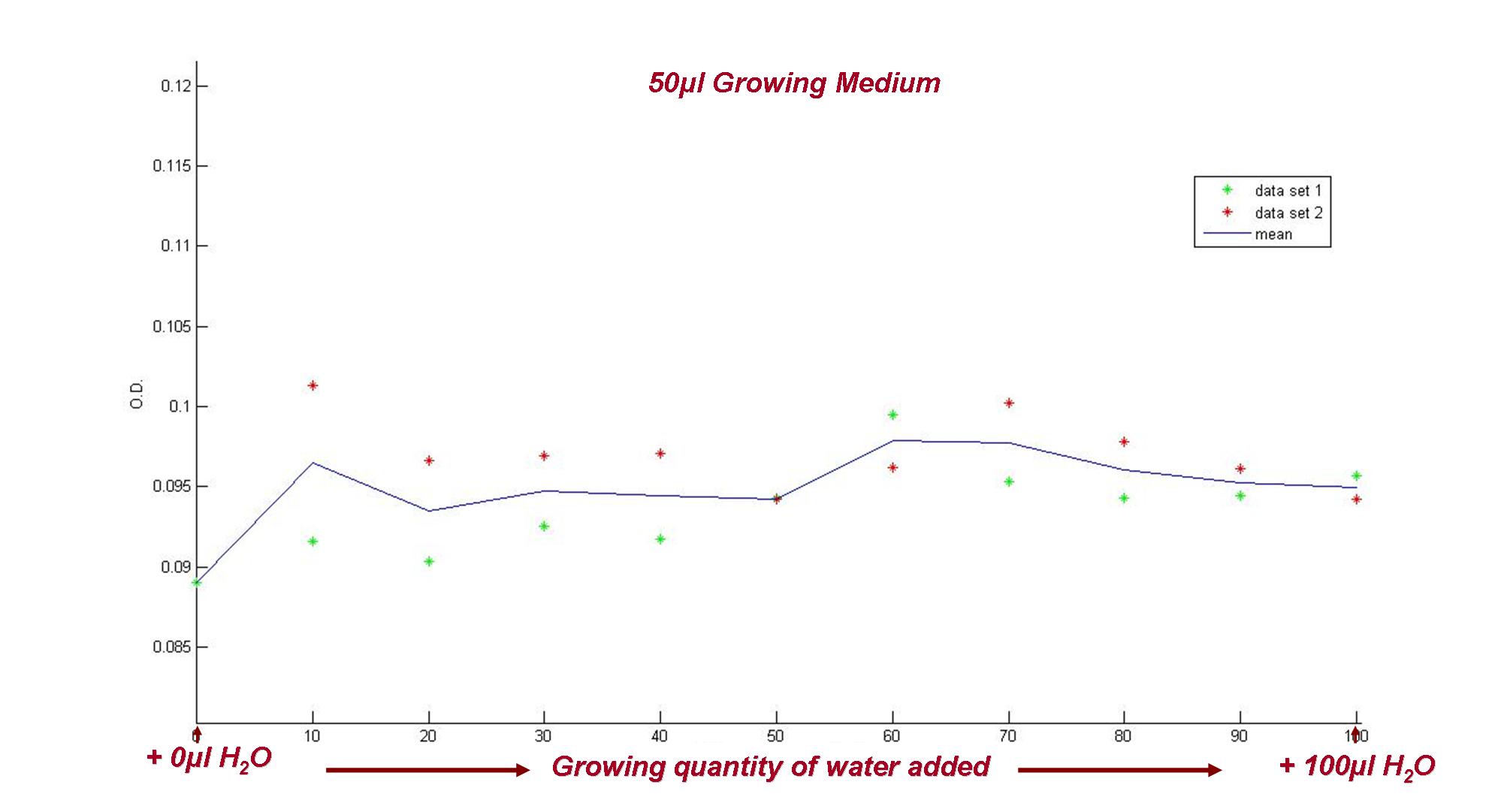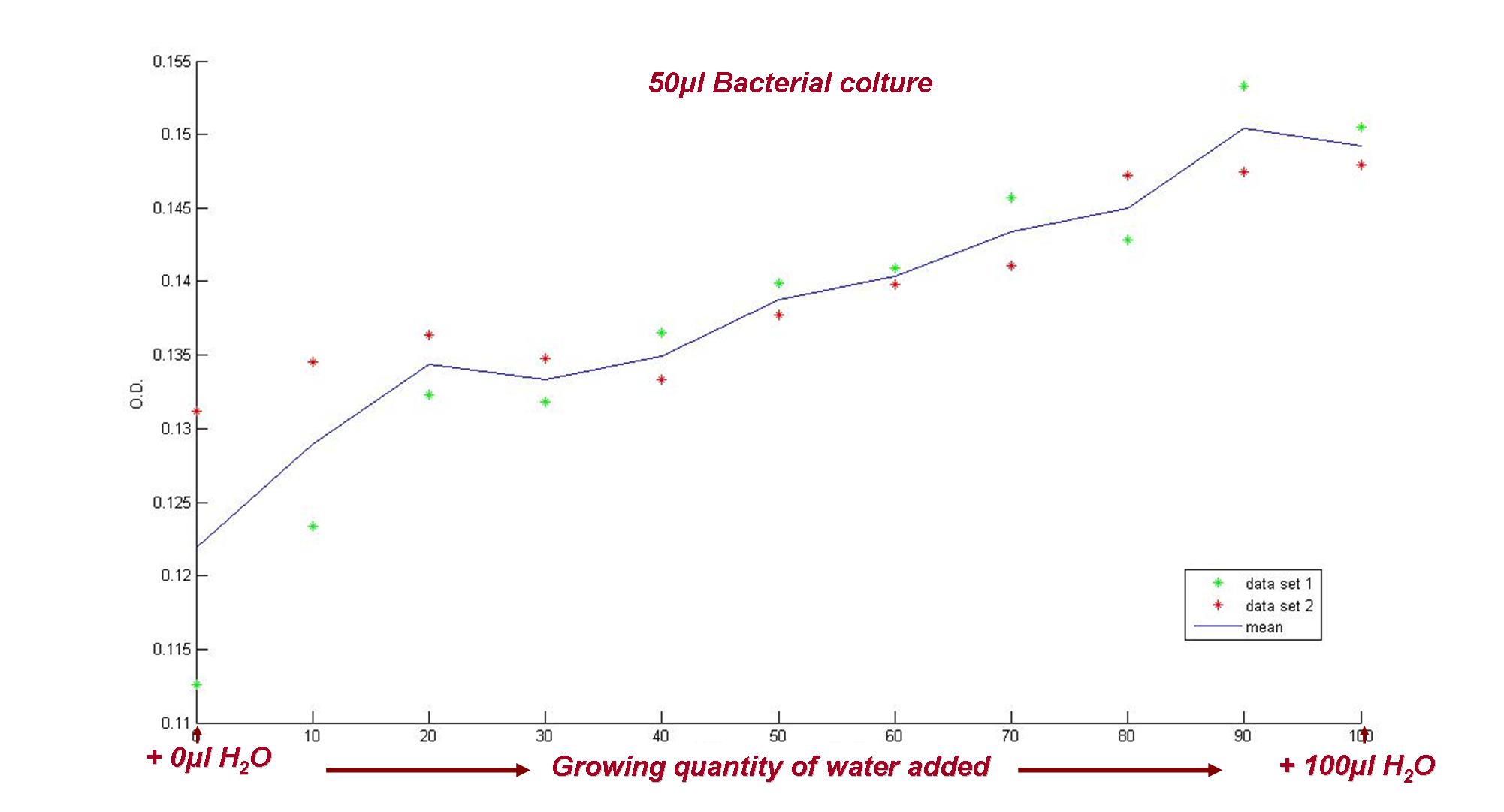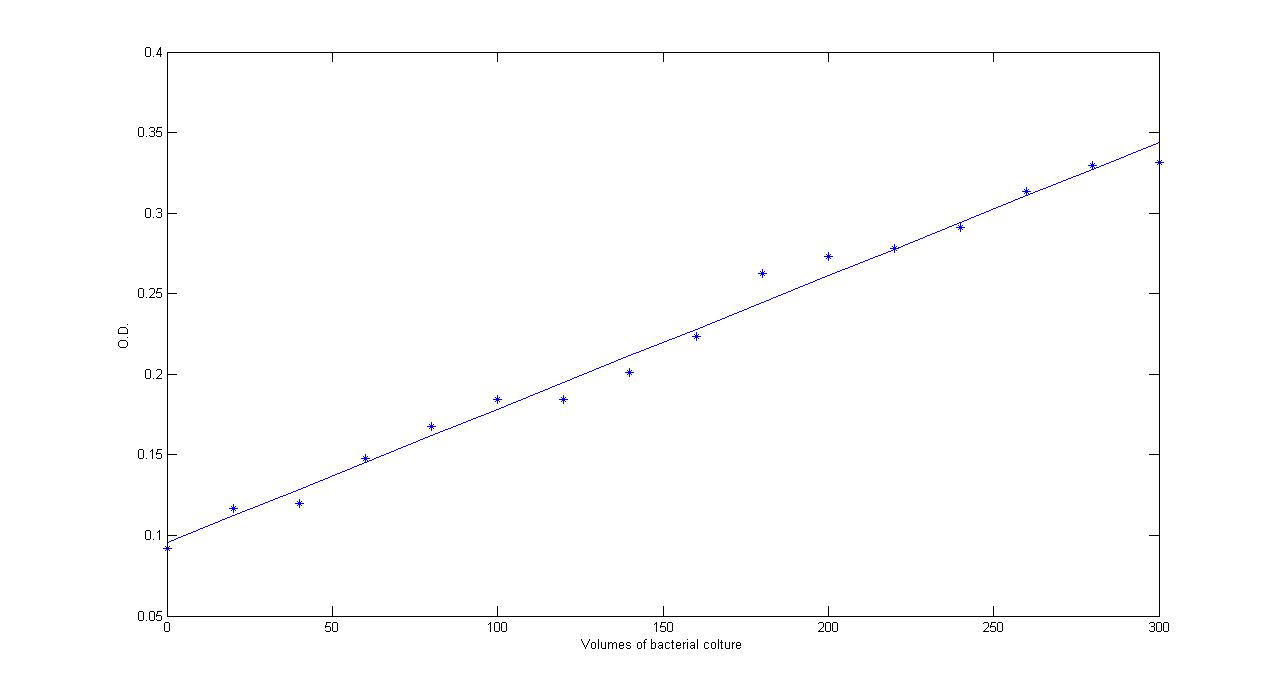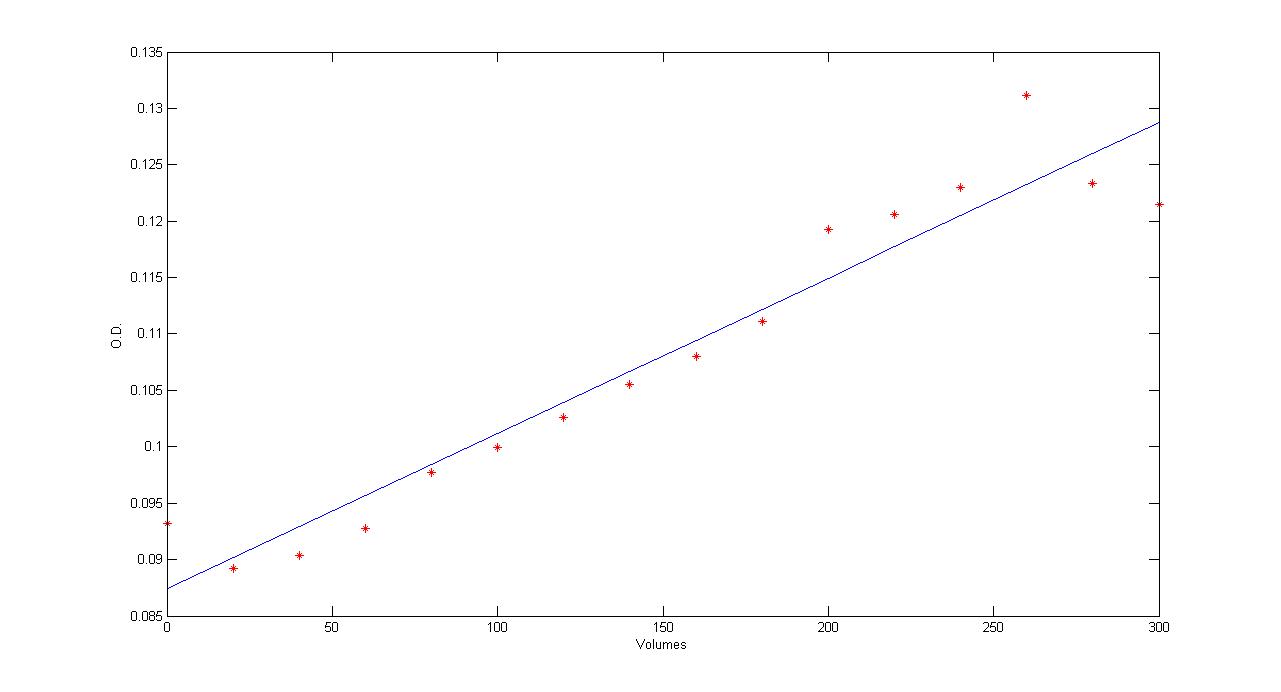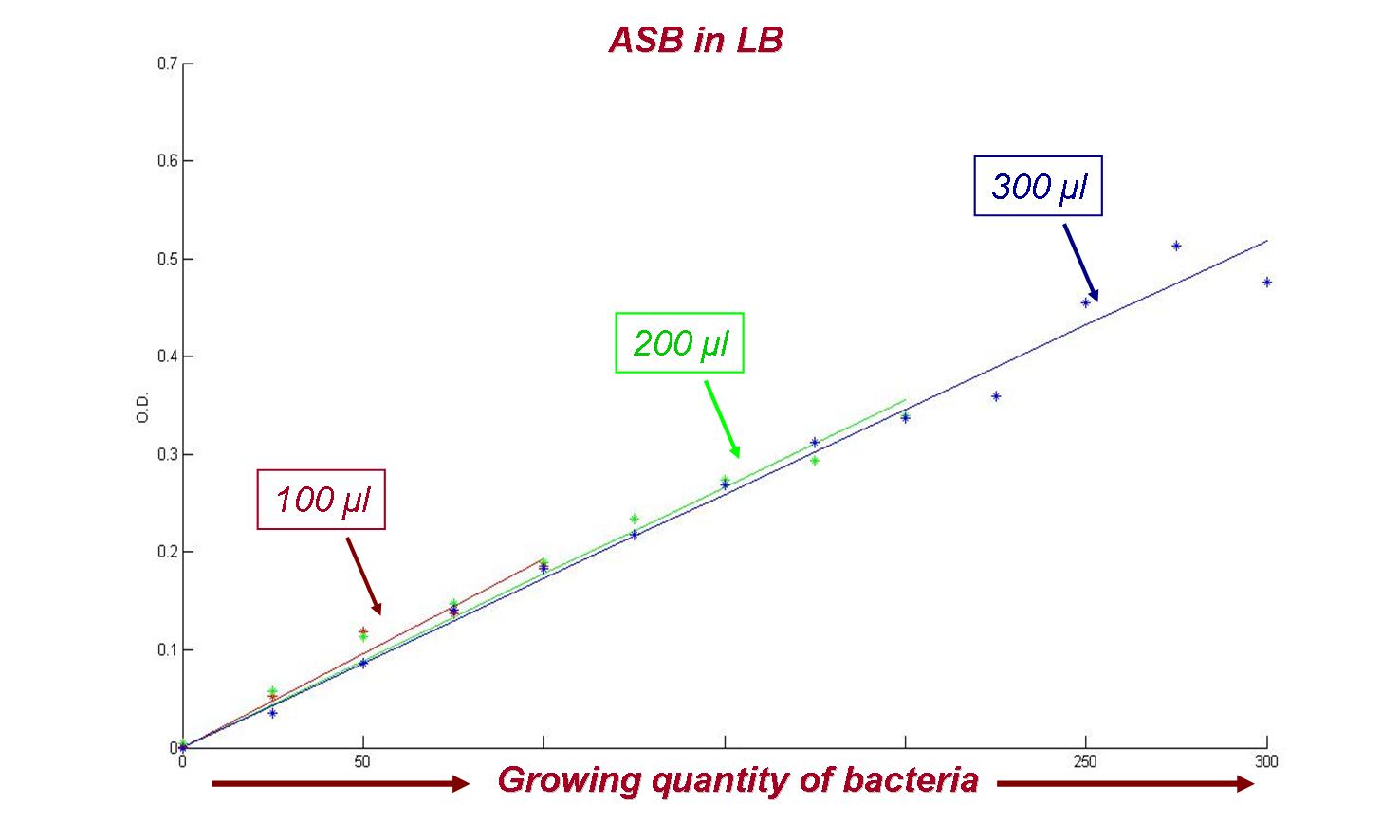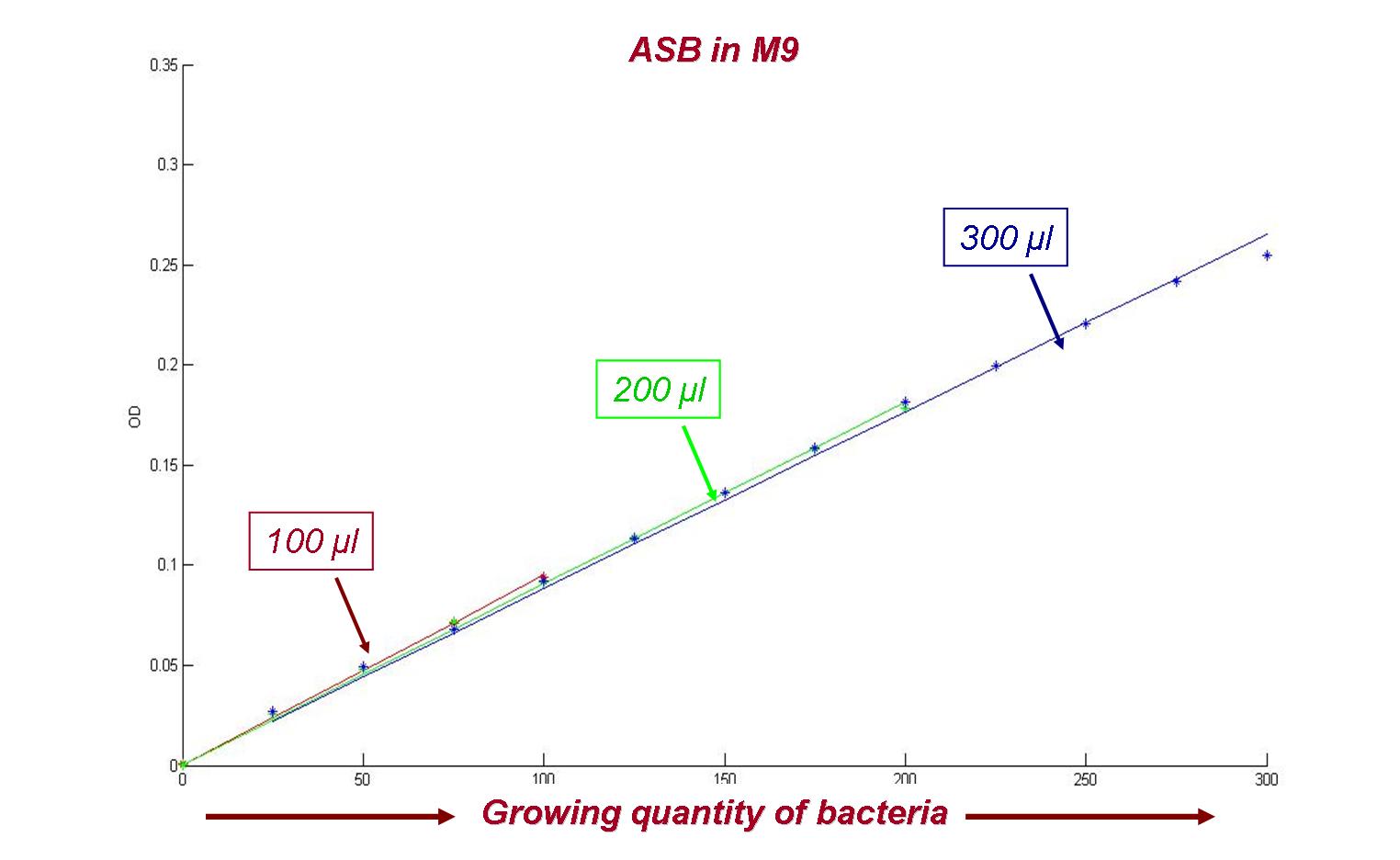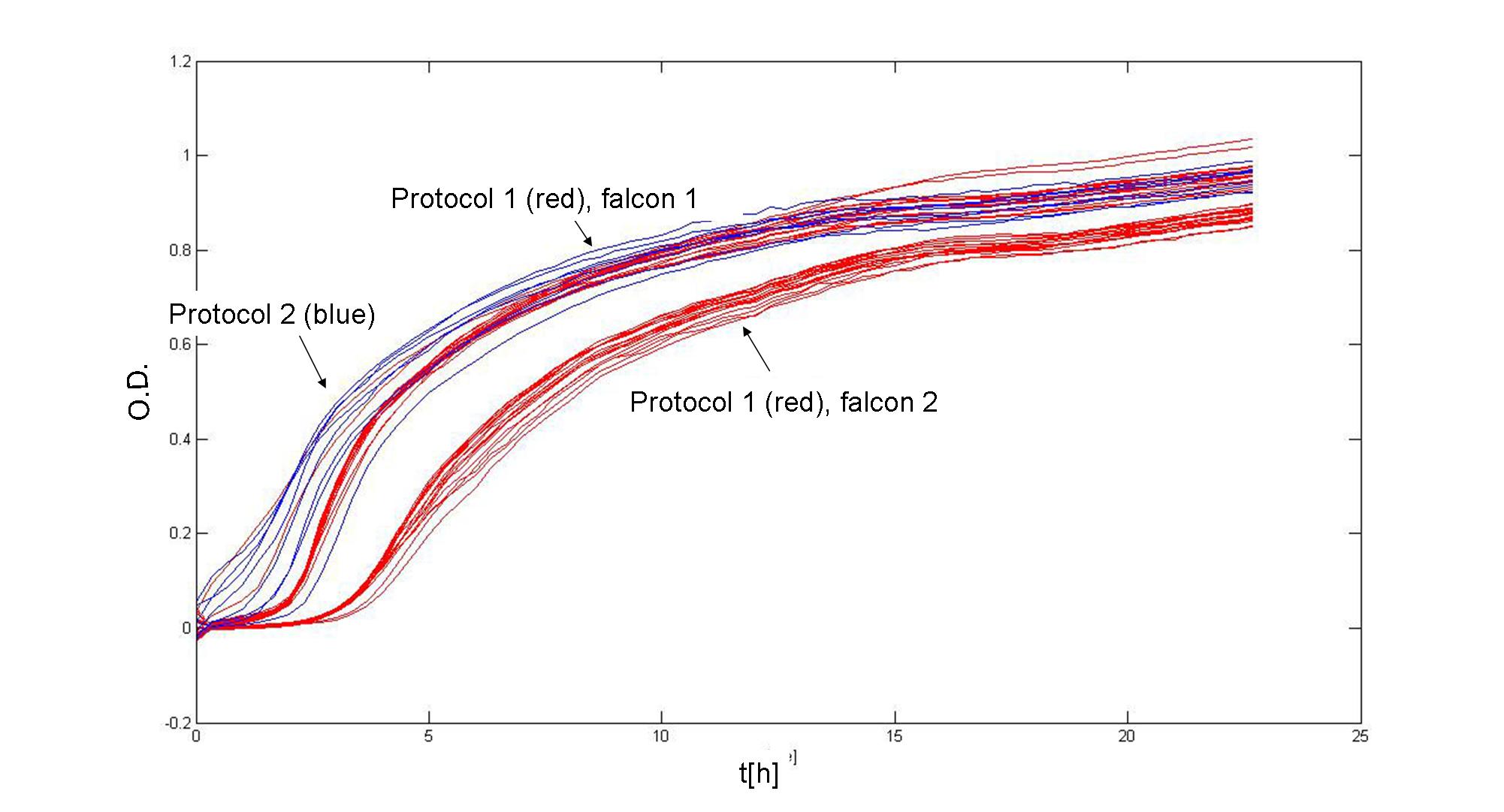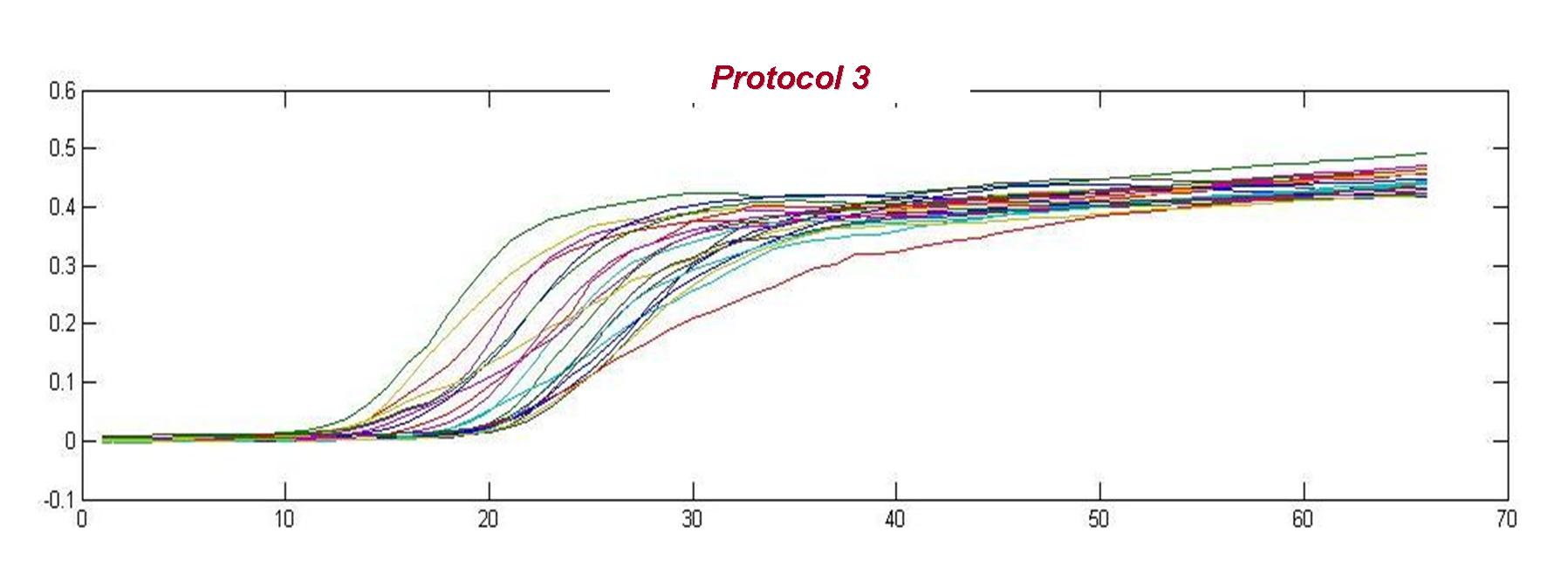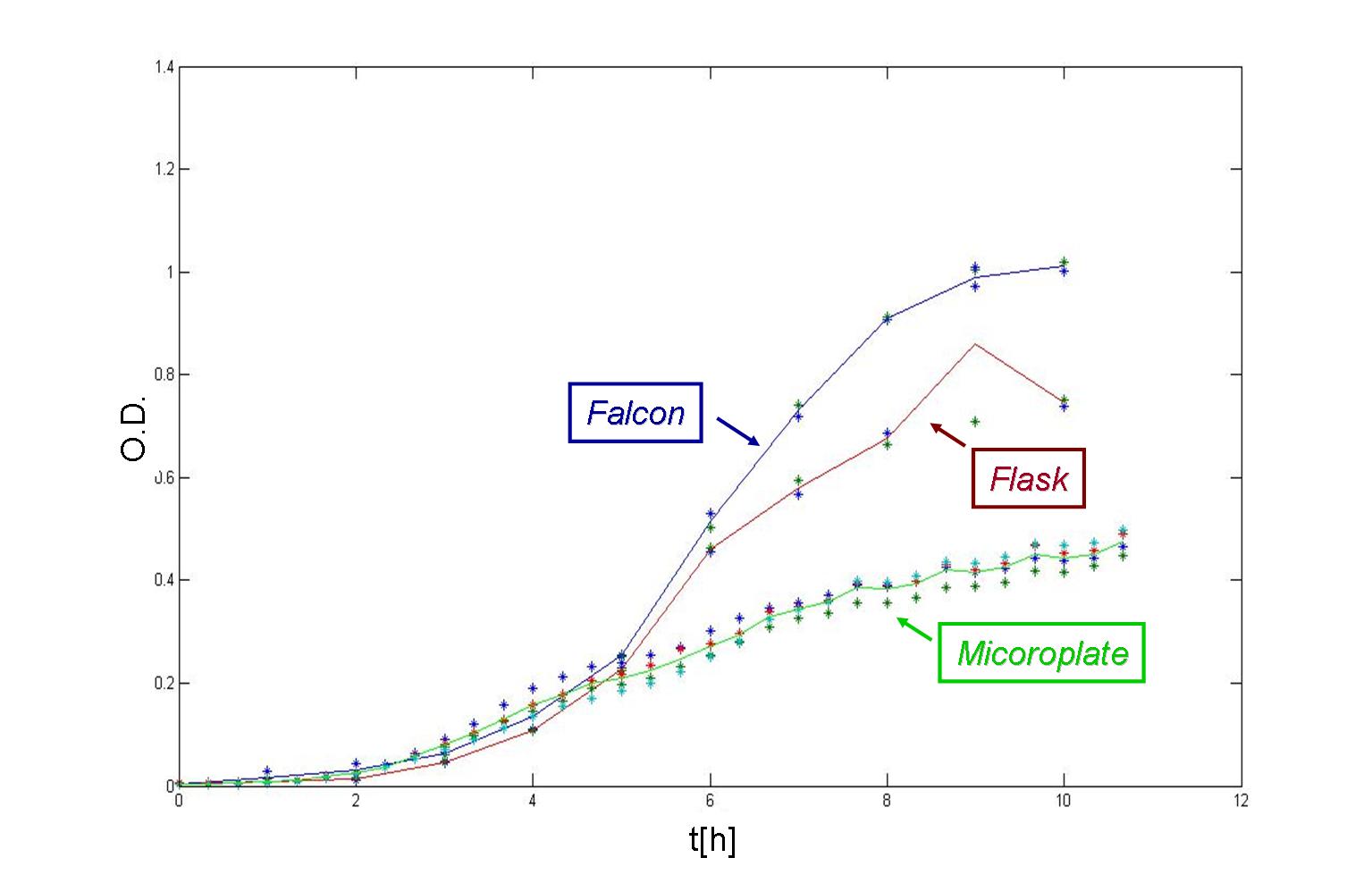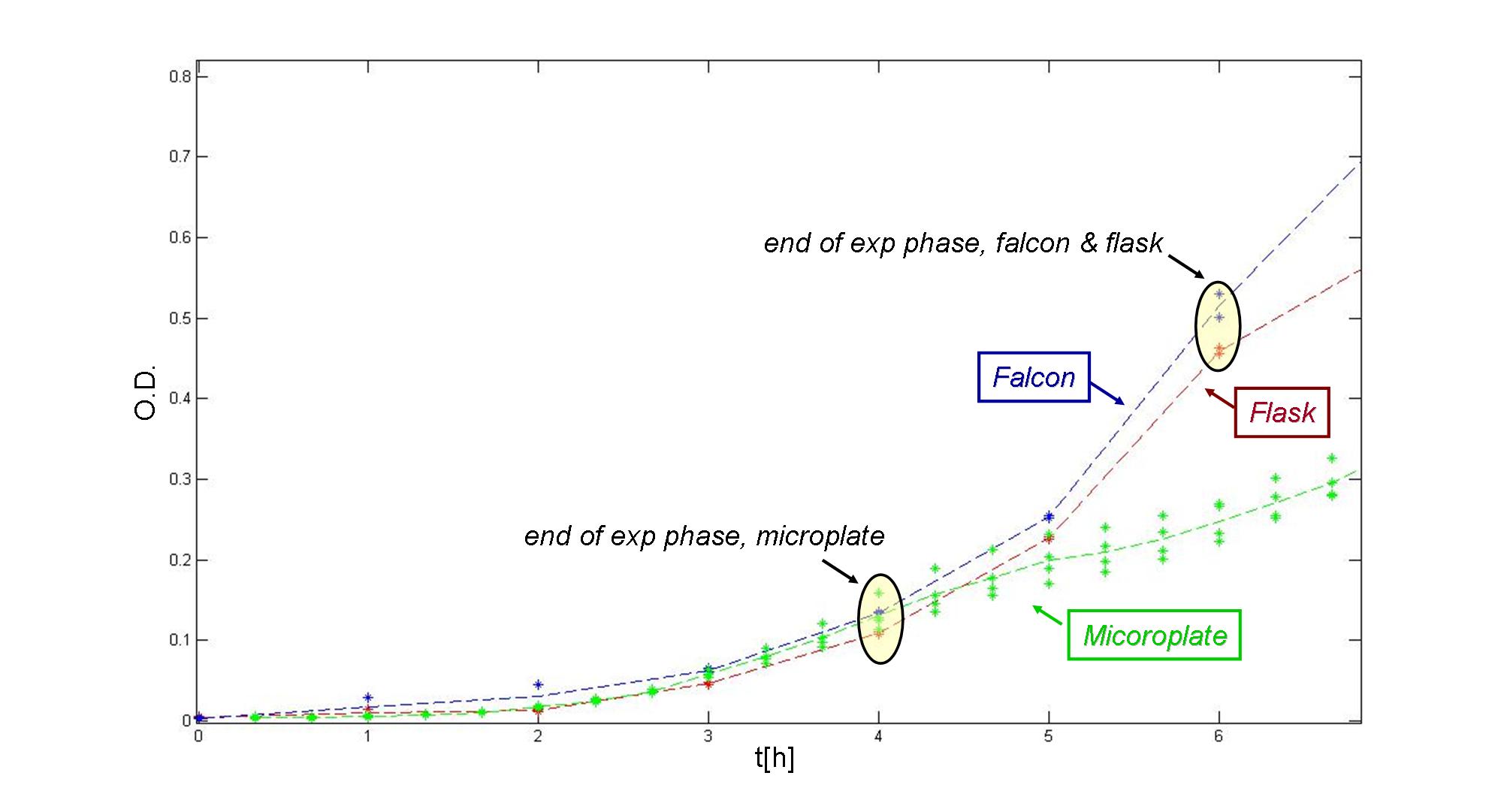Team:UNIPV-Pavia/Methods Materials/Absorbance
From 2009.igem.org
(→Absorbance and water dispensation) |
m |
||
| (7 intermediate revisions not shown) | |||
| Line 31: | Line 31: | ||
We find no relevant differences between the measures before and after the dispensation of different volumes of water in the well. As regards liquid growth medium these differences are practically null, in the case of bacterial coltures, instead, there is a positive trend, but the values vary into a negligible interval. | We find no relevant differences between the measures before and after the dispensation of different volumes of water in the well. As regards liquid growth medium these differences are practically null, in the case of bacterial coltures, instead, there is a positive trend, but the values vary into a negligible interval. | ||
| - | You can find more informations about the experiment at | + | You can find more informations about the experiment at <html><a href="http://aimed11.unipv.it/iGEM2009/TestTECANInfiniteF200/Test%2017_10_09/" target="_blank">Download Protocol</a></html> - Test 17/10/09. |
| Line 43: | Line 43: | ||
By fitting a linear regression model on the experimental data we estimate a coefficient of proportionality of 8.27e-4 for bacterial cultures and of 1.38e-4 for LB+Amp medium. | By fitting a linear regression model on the experimental data we estimate a coefficient of proportionality of 8.27e-4 for bacterial cultures and of 1.38e-4 for LB+Amp medium. | ||
| - | You can find more informations about the experiments at | + | You can find more informations about the experiments at <html><a href="http://aimed11.unipv.it/iGEM2009/TestTECANInfiniteF200/10_10_09test9bis/" target="_blank">Download Protocol</a></html> - Test n.9bis, 10/10/09 (bacterial colture), and at <html><a href="http://aimed11.unipv.it/iGEM2009/TestTECANInfiniteF200/Test%2017_10_09/" target="_blank">Download Protocol</a></html> - Test 17/10/09 (LB medium). |
| Line 61: | Line 61: | ||
By fitting a linear regression model on the experimental data shown in the two figures below, we estimate a coefficient of proportionality of 0.0018 for LB medium and 0.0035 of for M9. | By fitting a linear regression model on the experimental data shown in the two figures below, we estimate a coefficient of proportionality of 0.0018 for LB medium and 0.0035 of for M9. | ||
| - | You can find more informations about the experiments at | + | You can find more informations about the experiments at <html><a href="http://aimed11.unipv.it/iGEM2009/TestTECANInfiniteF200/13_08_09Test20/" target="_blank">Download Protocol</a></html> - Test n.20, 13/08/09 and Test n.20 "M9", 28/08/09. |
| Line 93: | Line 93: | ||
[[Image:unipv_asb_protocols_12.jpg| 500px|Growth Protocols n.1 and n.2|thumb|center|Growth Protocols n.1 and n.2]] | [[Image:unipv_asb_protocols_12.jpg| 500px|Growth Protocols n.1 and n.2|thumb|center|Growth Protocols n.1 and n.2]] | ||
| - | You can find more informations about the experiment at | + | You can find more informations about the experiment at <html><a href="http://aimed11.unipv.it/iGEM2009/TestTECANInfiniteF200/18_06_09%20Test5/" target="_blank">Download Protocol</a></html> - Test n.5, 18/06/09. |
| Line 104: | Line 104: | ||
[[Image:unipv_asb_protoco3.jpg| 500px|Growth Protocol n.3|thumb|center|Growth Protocol n.3]] | [[Image:unipv_asb_protoco3.jpg| 500px|Growth Protocol n.3|thumb|center|Growth Protocol n.3]] | ||
| - | You can find more informations about the experiment at | + | You can find more informations about the experiment at <html><a href="http://aimed11.unipv.it/iGEM2009/TestTECANInfiniteF200/27_06_09%20Test%206/" target="_blank">Download Protocol</a></html> - Test n.6, 27/06/09. |
| Line 113: | Line 113: | ||
A 10-hour experiment was made to compare the growth in the microplate (200 ul of culture) with those in typical growth ambients like 50 ml falcon tube (30 ml of culture) and 500 ml flask (200 ml of culture), especially in the exponential phase. The goal was the estimation of important parameters that characterize growth curves, as duration and evolution of all the phases, and doubling time in exponential phase. | A 10-hour experiment was made to compare the growth in the microplate (200 ul of culture) with those in typical growth ambients like 50 ml falcon tube (30 ml of culture) and 500 ml flask (200 ml of culture), especially in the exponential phase. The goal was the estimation of important parameters that characterize growth curves, as duration and evolution of all the phases, and doubling time in exponential phase. | ||
| - | As you can see in the figures below, the growth inside the microplate is well comparable to the other two till the end of its exponential phase (4 hour, estimation done on the logarithm of the blanked data), then slowes down, becoming almost linear, to reach O.D. values lower than the others (0.4). At the end of the exponential phase the O.D. measurement is 0.14 and the doubling time estimate is 40 minutes (referring to the logistic growth model): parameters consistent with those present in literature. | + | As you can see in the figures below, the growth inside the microplate is well comparable to the other two till the end of its exponential phase (4 hour, estimation done on the logarithm of the blanked data), then slowes down, becoming almost linear, to reach O.D. values lower than the others (0.4). At the end of the exponential phase the O.D. measurement is 0.14 and the doubling time estimate is 40 minutes (referring to the logistic growth model): these parameters are consistent with those present in the literature. |
As regards the other ambients, we observed a longer exponential phase (about 6 hours), with a final O.D. value of 0.46 for the flask and 0.51 for the falcon tube, and a doubling time of 55 minutes for both ambients. | As regards the other ambients, we observed a longer exponential phase (about 6 hours), with a final O.D. value of 0.46 for the flask and 0.51 for the falcon tube, and a doubling time of 55 minutes for both ambients. | ||
| - | This analysis allows us to individuate another important protocol to observe the exponential phase, which is the optimal growth phase and is very important for gene expression of sigma70 promoters. The starting point is protocol n.1, described in [[Team:UNIPV-Pavia/Methods_Materials/Absorbance#Different protocols for different growth curves|Different protocols for different growth curves]], the new step is performing a dilution after the 2/3-hours incubation till reaching an O.D. value of about 0.02: wells filled with this diluted culture will be in the exponential phase for about two hours after the incubation and all the cultures will start to grow in the microplate at the same O.D | + | This analysis allows us to individuate another important protocol to observe the exponential phase, which is the optimal growth phase and is very important for gene expression of sigma70 promoters. The starting point is protocol n.1, described in [[Team:UNIPV-Pavia/Methods_Materials/Absorbance#Different protocols for different growth curves|Different protocols for different growth curves]], the new step is performing a dilution after the 2/3-hours incubation till reaching an O.D. value of about 0.02: wells filled with this diluted culture will be in the exponential phase for about two hours after the incubation and all the cultures will start to grow in the microplate at the same O.D. |
Latest revision as of 16:10, 19 October 2009

|
|
|
Measurements - Absorbance |
|
|
Absorbance and water dispensationWe find no relevant differences between the measures before and after the dispensation of different volumes of water in the well. As regards liquid growth medium these differences are practically null, in the case of bacterial coltures, instead, there is a positive trend, but the values vary into a negligible interval. You can find more informations about the experiment at Download Protocol - Test 17/10/09.
Absorbance and volumeThe proportionality between absorbance (OD600) measurement and volume of colture in the well was verified. By fitting a linear regression model on the experimental data we estimate a coefficient of proportionality of 8.27e-4 for bacterial cultures and of 1.38e-4 for LB+Amp medium. You can find more informations about the experiments at Download Protocol - Test n.9bis, 10/10/09 (bacterial colture), and at Download Protocol - Test 17/10/09 (LB medium).
Absorbance and dilutions in liquid growth mediumThe proportionality between absorbance measurement (OD600) and culture's dilutions was verified, confirming the possibility of using OD600 to measure the bacterial quantity in the well, regardless of the total volume present in the well. This experiment was done in two different growth media, LB and M9 supplemented + glycerol, and in three different total volumes in the well, 100μl, 200μl and 300μl. By fitting a linear regression model on the experimental data shown in the two figures below, we estimate a coefficient of proportionality of 0.0018 for LB medium and 0.0035 of for M9. You can find more informations about the experiments at Download Protocol - Test n.20, 13/08/09 and Test n.20 "M9", 28/08/09.
Different protocols for different growth curvesAs our first step of standard measurements in Synthetic Biology, we wanted to individuate a proper protocol to have reproducible growth curves for the cultures incubated inside the microplate reader. We compared three different solutions, as you can see in the figures below. Protocol 1:
Protocol 2:
Protocol 3:
You can find more informations about the experiment at Download Protocol - Test n.5, 18/06/09.
On the other hand, protocol n.1 ensures a perfect reproducibility of the curves coming from the same falcon tube. Clearly cultures from different falcon tubes evolve in different way. For all these reasons we decided to consider this protocol for our experiments.
You can find more informations about the experiment at Download Protocol - Test n.6, 27/06/09.
Growth ambients in comparisonA 10-hour experiment was made to compare the growth in the microplate (200 ul of culture) with those in typical growth ambients like 50 ml falcon tube (30 ml of culture) and 500 ml flask (200 ml of culture), especially in the exponential phase. The goal was the estimation of important parameters that characterize growth curves, as duration and evolution of all the phases, and doubling time in exponential phase. As you can see in the figures below, the growth inside the microplate is well comparable to the other two till the end of its exponential phase (4 hour, estimation done on the logarithm of the blanked data), then slowes down, becoming almost linear, to reach O.D. values lower than the others (0.4). At the end of the exponential phase the O.D. measurement is 0.14 and the doubling time estimate is 40 minutes (referring to the logistic growth model): these parameters are consistent with those present in the literature. As regards the other ambients, we observed a longer exponential phase (about 6 hours), with a final O.D. value of 0.46 for the flask and 0.51 for the falcon tube, and a doubling time of 55 minutes for both ambients. This analysis allows us to individuate another important protocol to observe the exponential phase, which is the optimal growth phase and is very important for gene expression of sigma70 promoters. The starting point is protocol n.1, described in Different protocols for different growth curves, the new step is performing a dilution after the 2/3-hours incubation till reaching an O.D. value of about 0.02: wells filled with this diluted culture will be in the exponential phase for about two hours after the incubation and all the cultures will start to grow in the microplate at the same O.D.
|
 "
"

